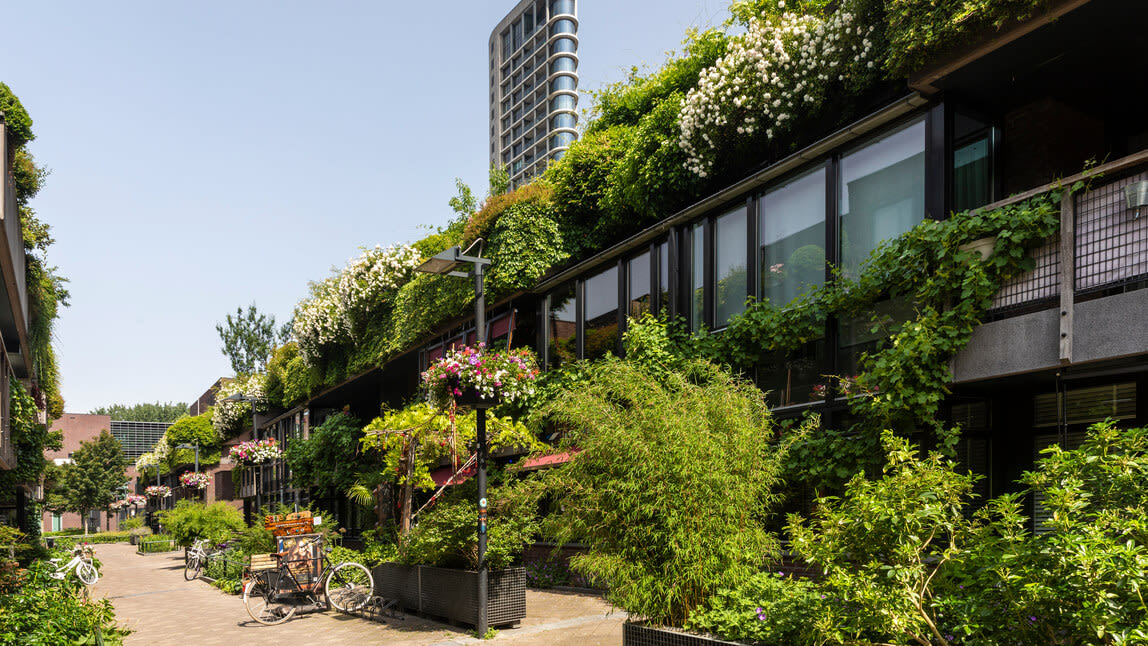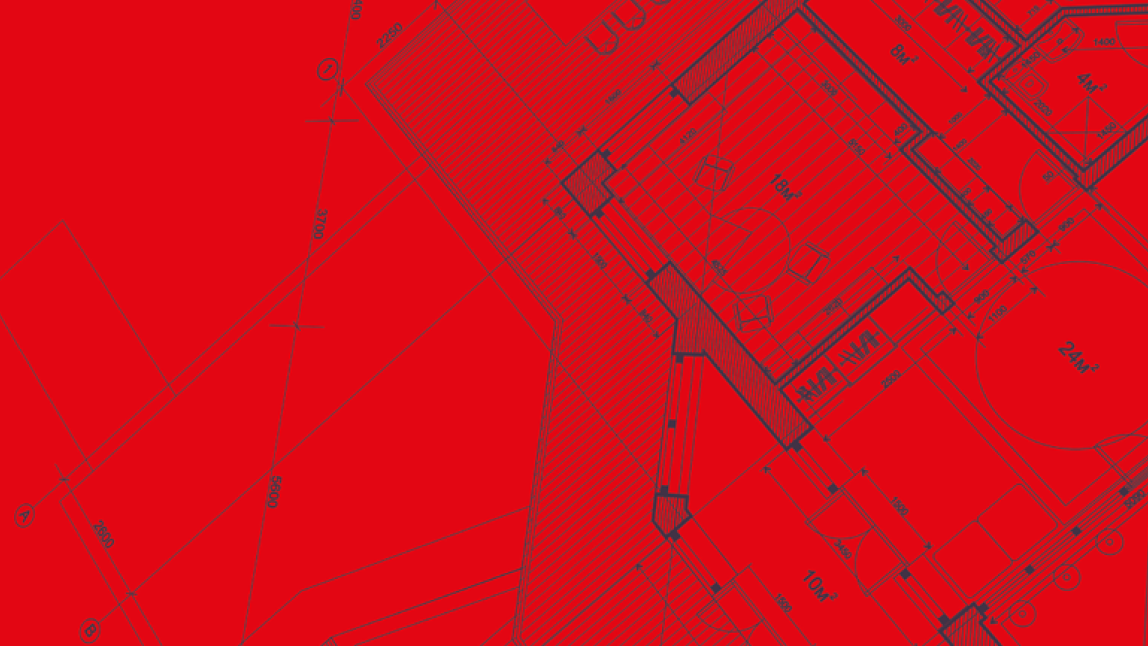Cities play a central role in the global economy. Home to more than half of the world’s population, they are creative, innovative centres of growth.
This deep dive explores how applying the principles of the circular economycircular economyA systems solution framework that tackles global challenges like climate change, biodiversity loss, waste, and pollution. It is based on three principles, driven by design: eliminate waste and pollution, circulate products and materials (at their highest value), and regenerate nature. to urban development will create cities that are able to thrive in the long-term, bringing prosperity to their citizens within planetary boundaries. Buildings, mobility, products and services, and food systems are examined in detail as these are urban systems that play an important role in our lives, and where transformations can be made. Added to this, they can be managed at the local level and can have significant impact. Within each of these systems the opportunities offered by innovations in design, business models, and digital technology are highlighted.
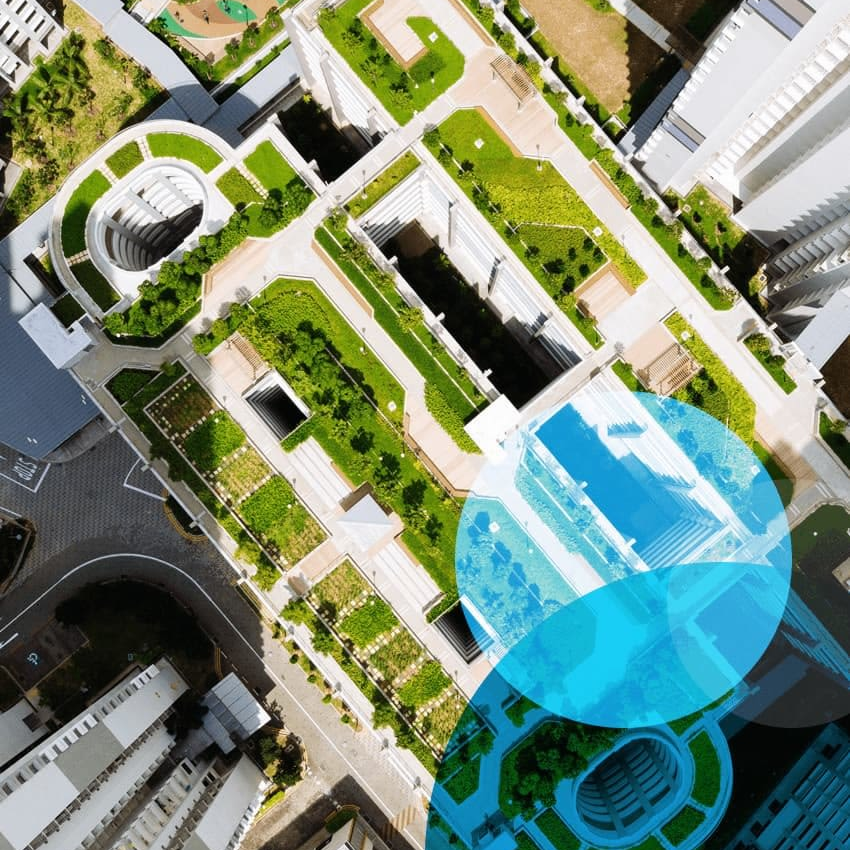
What potential does the circular economy hold for cities?
Implementing the circular economy in cities can bring tremendous economic, social, and environmental benefits.
The implementation of a circular economy vision could foster the emergence of:
Thriving cities in which economic productivity increases through reduced congestion, eliminated waste, and reduced costs. New growth and business opportunities support skills development and jobs
Liveable cities with improved air quality, reduced pollution, and enhanced social interactions
Resilient cities, reducing reliance on raw materials by keeping products in use and balancing local production with global supply chains
These benefits can be achieved by changing the way urban systems are planned, designed, and financed, and how they are made, used, and repurposed. This vision aligns with the 2030 Sustainable Development Goals, including reducing greenhouse gas emissions and adapting to the effects of climate change.
Why are cities important in the transition to a circular economy?
Cities make perfect hubs for innovation.
Cities account for 85% of global GDP generation and are also huge collectors of materials and nutrients, accounting for 75% of natural resource consumption. Cities also produce 50% of global waste and 60-80% of greenhouse gas emissions. These are symptoms of the ‘take, make, waste’ linear economylinear economyAn economy in which finite resources are extracted to make products that are used - generally not to their full potential - and then thrown away ('take-make-waste')..
With their high concentration of resources, capital, data, and talent spread over a relatively small geographic area, cities are uniquely positioned to drive a global transition towards a circular economy.

Urban systems and the circular economy
The circular economy has been described as a concept that mimics living systems. One particular living system that may be helpful when thinking about cities is the human body. A human body is made up of many subsystems - e.g. circulatory, respiratory, and digestive. A healthy body requires each of these systems to work effectively in conjunction with the others. They are interdependent, dynamic systems, constantly responding and adapting to change. Bodies work because materials, such as blood and oxygen, flow through them.
A city is no different. In a healthy city, urban systems such as buildings,� mobility, products and services, and food, also need to work effectively in conjunction with one another. And things also need to flow - for example, materials, capital, knowledge, data, and energy. A helpful reframing, consistent with a circular economy approach, is to think of cities as living systems that rely on a healthy circulation of resources.
Underpinning each urban system is a set of recurring themes integral to the circular economy. These include but are not limited to: the role of design, new business models and means of access, and use of digital technology.
Buildings
The world’s building stock is expected to double by 2060, the equivalent of building another New York City every month.
According to National Geographic, buildings in cities account for more than 30% of global greenhouse gas emissions. Added to this is the ineffective use of materials and space leading to significant economic losses, and a huge demand for housing. (One third of urban residents lack decent housing.)

The graphic above highlights the ‘waste’ associated with a typical European city.
If we are to build thriving, liveable, resilient cities, we clearly need to start thinking and acting differently when it comes to buildings. Architects, designers, urban planners, engineers, businesses, and policy makers all need to be involved in the process of redesigning our urban systems.
Building design for a circular economy
Creating flexible and dynamic buildings.
Imagine the possibilities if buildings were designed like Lego. Easily assembled and disassembled, their different components or materials could be recovered and reused rather than being landfilled.
Building with new materials
Paving the way for the circular economy.
Sourcing renewable, non-toxic materials will increase reusability/recyclabilityrecyclabilityThe ease with which a material can be recycled in practice and at scale., and ultimately allow for materials to be safely returned to the biosphere at end of life, thereby acting as ‘nutrients’ to grow new materials. In this model, buildings will produce rather than merely consume power and food. They will have fully closed water, nutrition, material, and energy loops. This is the vision behind the term ‘living buildings’ which is defined by the International Living Future Institute as, “buildings that give more than they take, creating a positive impact on the human and natural systems that interact with them.”
Growing better buildings
Arup’s Biobuild project is a good example of material innovation in buildings. Using natural fibres from hemp, jute, flax, and natural resins derived from sugar cane, and corn, the project aims to create entirely non-toxic building facades known as ’biocomposites’. Arup’s 2017 report, The Urban Bio-loop: Growing, making and regenerating, states that:
“biocomposites can reduce the embodied energy of building components when compared to conventional construction materials, and produce no increase in cost. At the same time, they increase the thermal performance of the building.”
Use of technology in buildings
Unlocking circular potential.
Much progress can be made by integrating ‘smart’ technology such as responsive heating, ventilation, and air conditioning (HVAC) systems, and smart meters that provide greater transparency on energy consumption and cost. Solutions for retrofitting existing buildings by improving insulation and incorporating smart meters are estimated to reduce energy consumption in Europe by 20-30%. Added to this, the rise in open source design platforms like Wikihouse can support modular building design and adaptation to local needs and material supply. Finally, new business models are emerging to take full advantage of underutilised or idle space in cities, allowing people to share anything from office space and equipment, to parking spaces and spare rooms.
Take a look at our tech enable series here.
More established technologies such as solar PV are dropping considerably in price, and help buildings to produce energy. Green roofs are able to filter and capture rainwater. Recirculation of water within homes (e.g. using shower water to flush the toilet) is another way to reduce a home’s resource consumption.
The graphic below shows how technology can unlock the circular potential in buildings.
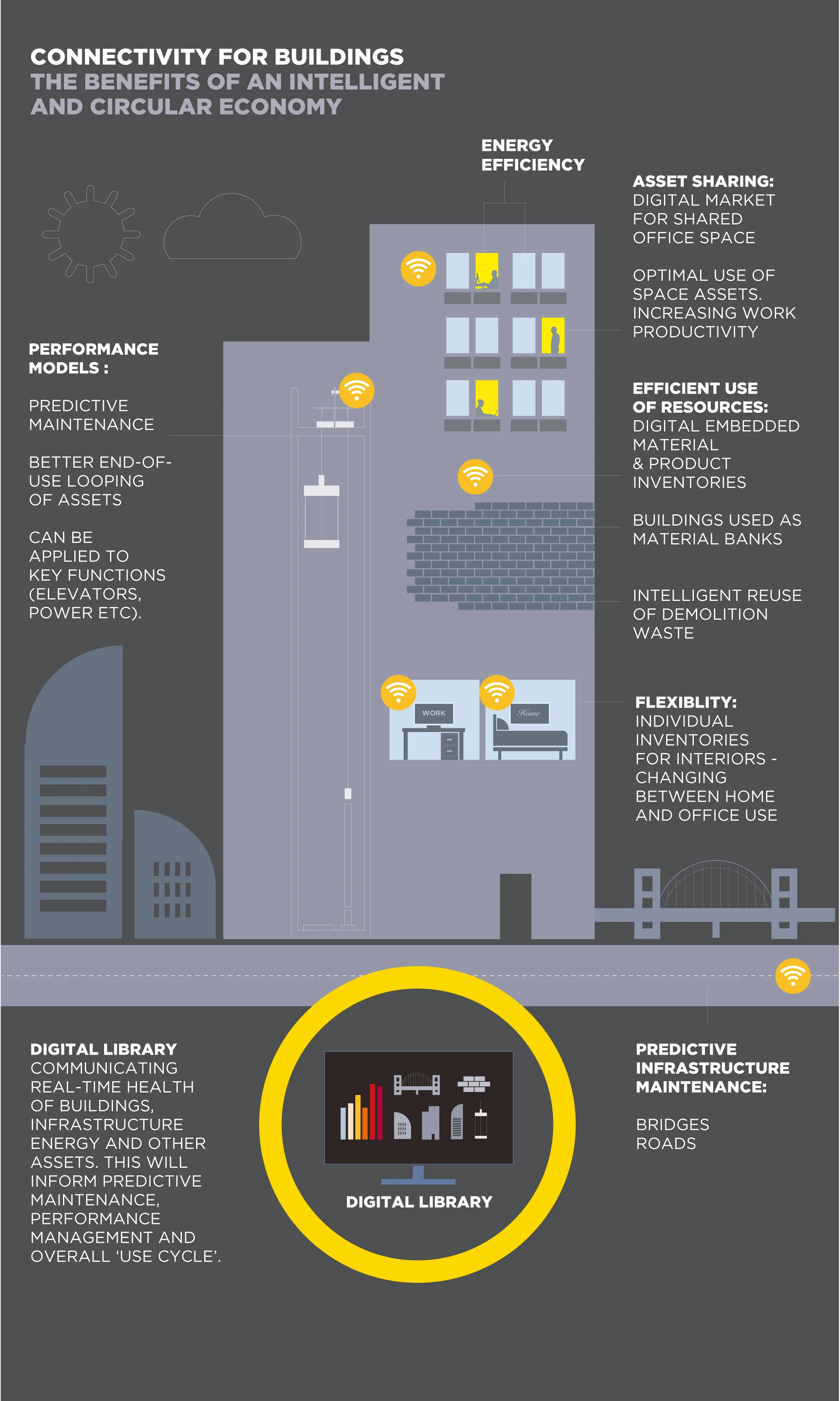
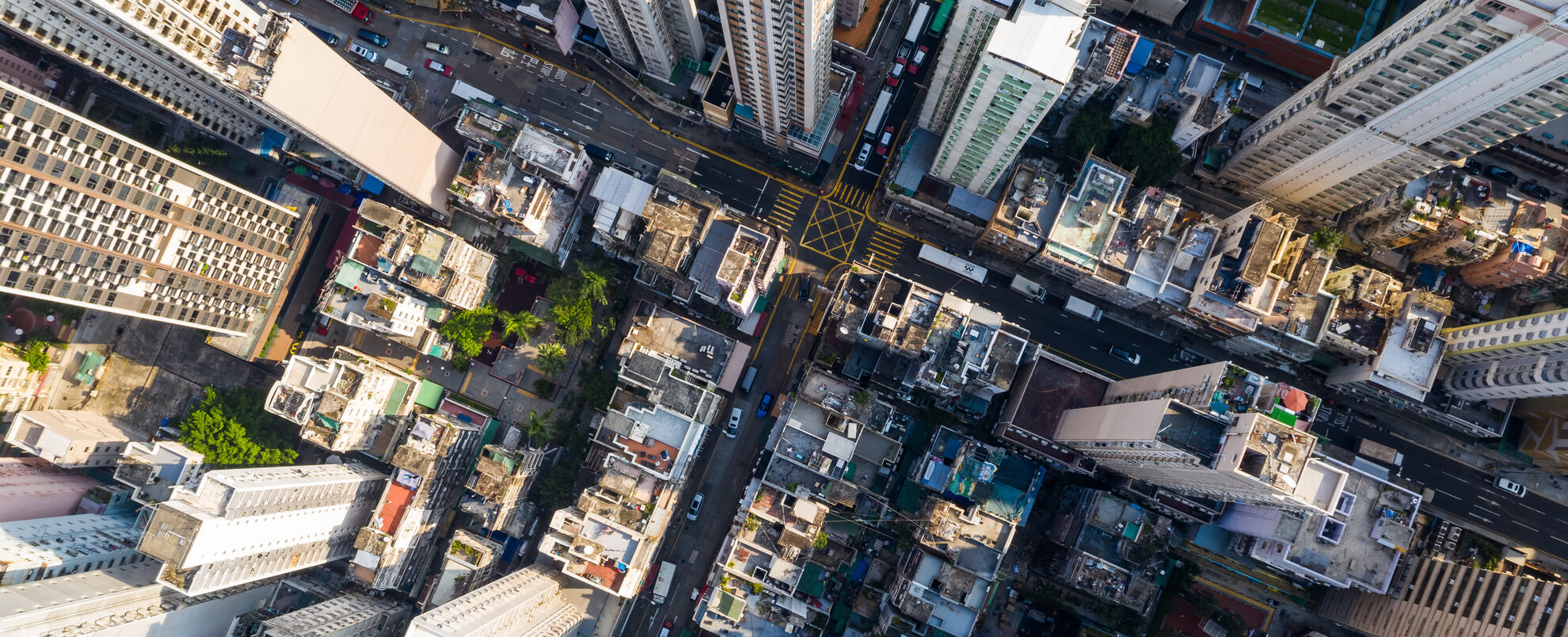
Pause for thought
There is a compelling case for a more flexible, circular approach to buildings, and much of the necessary technology is already available to us. Given this is the case, why do you think there are still so few examples of buildings designed in this way?

Mobility
The huge growth of urban areas in both size and population is putting considerable strain on mobility systems and infrastructure.
The car has been the primary mode of transport in the developed world for over half a century, and for good reason, yet there remain numerous issues. Cars are resource intensive to produce, have low utilisation rates, and are a source of noise and air pollution.
Ideally, we would have the benefits of personal vehicle use minus the negative aspects.
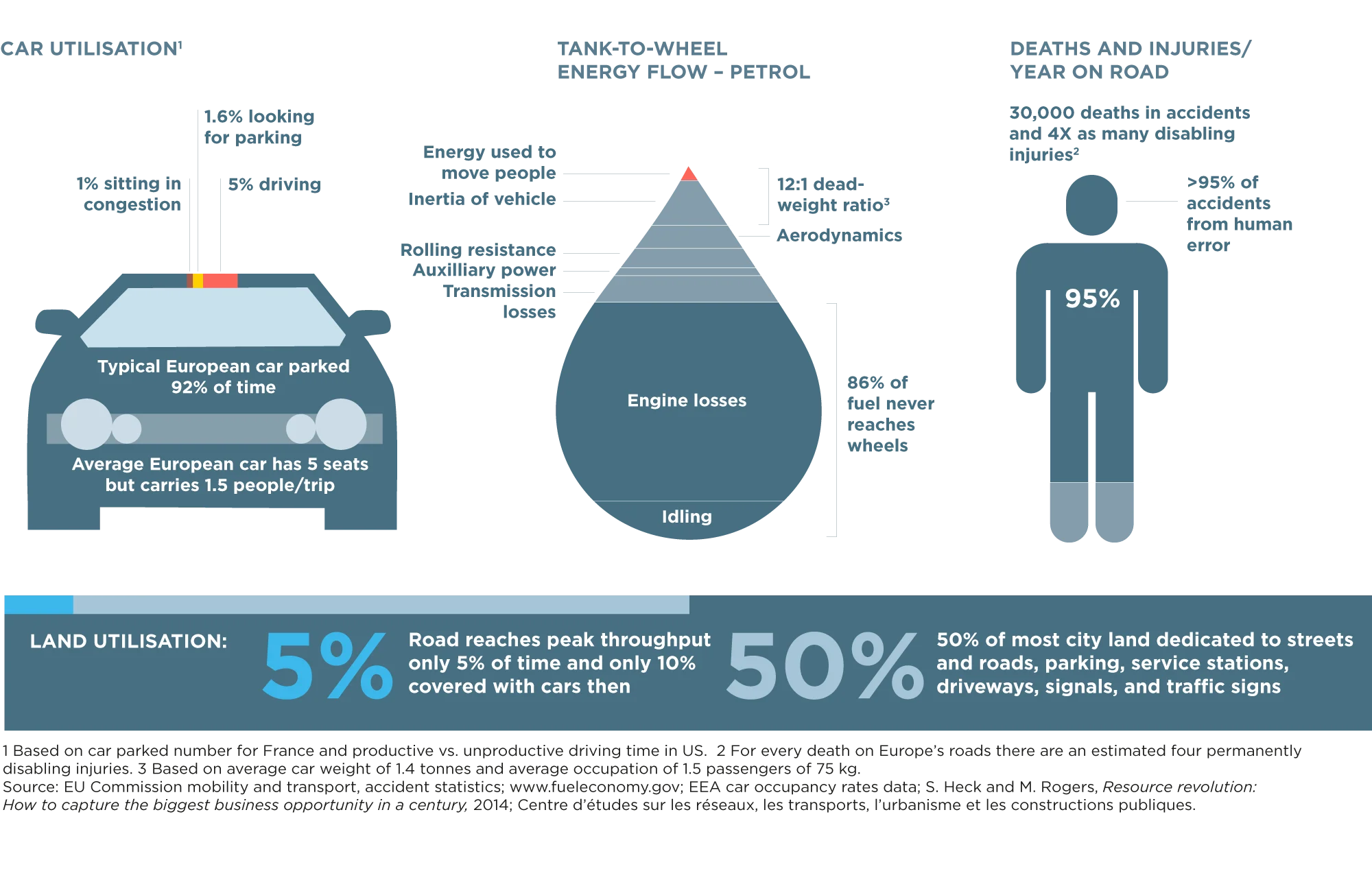

A circular mobility system
Connecting citizens with accessible, affordable, and effective transportation.
A circular mobility system would be multi-modal, which means it would offer a diverse range of mobility options to reflect the diverse needs of cities and their citizens. Most cities already have numerous transport options for users - shared cars, buses, trams, trains, and shared bikes etc. However, the promise of multi-modal mobility is to see these services work together to offer an all-in-one solution for the user. This would likely take the form of an app that would identify the best mode(s) of transport. These services are already in operation in cities such as Helsinki, and with increased connectivity, it is likely we will see more of them.
Among the most effective forms of transport in cities - foremost in the design plans for cities like London and Moscow - is active mobility such as walking and cycling. These fit with the vision of a circular economy because they are low impact, low cost, and have many associated health and economic benefits. It is likely, therefore, that cities will become increasingly oriented around this type of mobility.

Pause for thought
One criticism of automation is that it will lead to massive job losses. However, there is an argument that many new jobs will be created. Do you agree with that argument, and if so, what kind of jobs do you think will emerge?
Giving space back to people
In New York’s Times Square, retail sales rose sharply and pedestrian injuries were almost halved when space was returned to people.
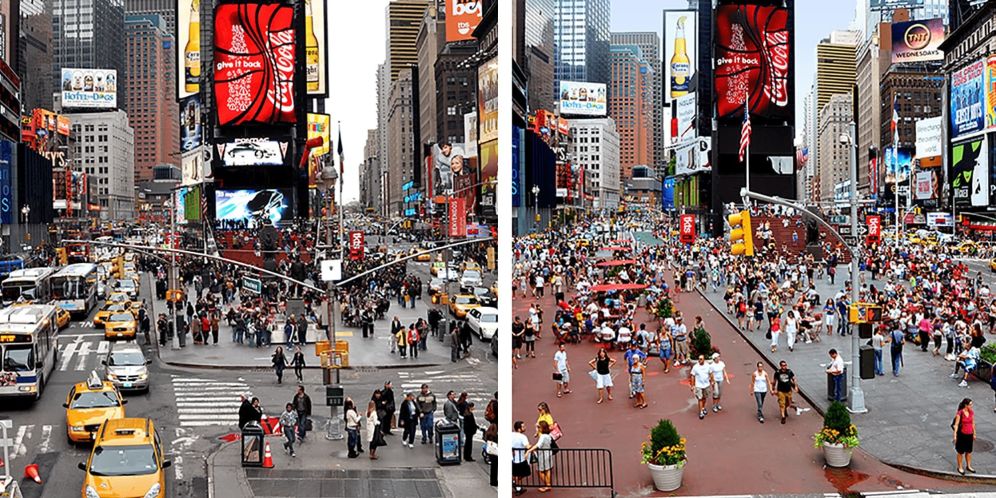
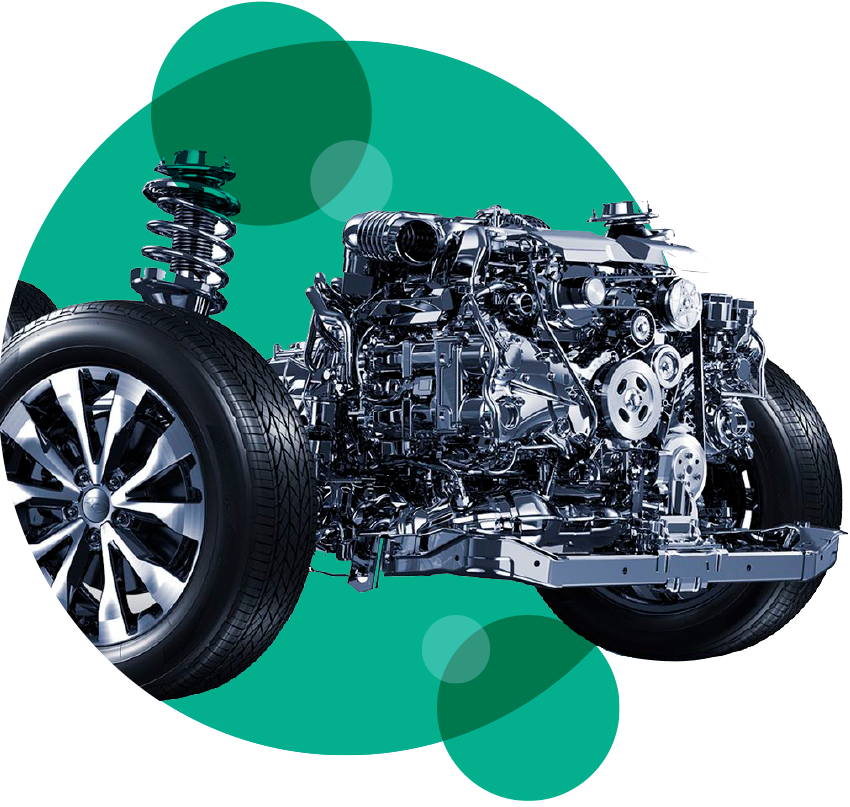
Circular vehicle design
Enabling repair, reuse, remanufacturing, and recycling of components and materials.
Regardless of how the vehicles are powered, or who or what drives them, we need to consider how vehicles are designed so that we can easily repair them during service, and recover and reuse their materials at end of use. A lot of energy is used to create vehicle parts, and that energy is not wasted if the parts - or materials - are reused.
Car manufacturer, Renault, is a good example. The company’s recycling scheme sees a variety of materials including copper, steel, textiles, and plastics taken from ‘end-of-life vehicles’ (ELV) and put into new vehicles with the same level of performance as virgin materials. Currently, 36% of the total mass of a newly produced Renault vehicle in Europe is made from recycled materials, and 85% of an ELV is recyclable. This approach forms a crucial part of the circular economy. Going even further than recycling, Renault remanufactures engines components and gearboxes at it’s factory in Choisy-le-Roi.
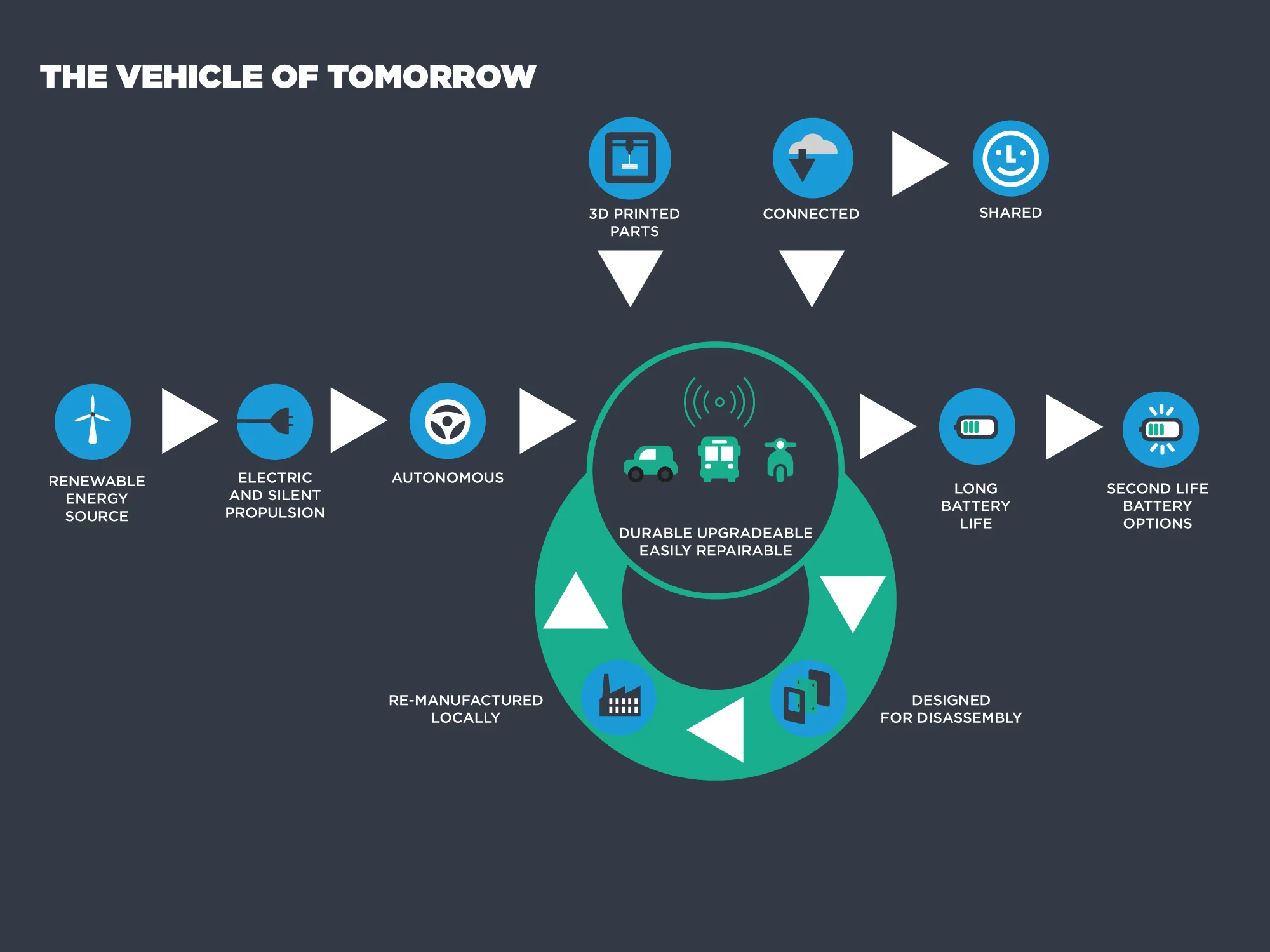

What mobility changes can we expect in the future?
The mobility system of tomorrow.
A McKinsey & Company article entitled, Mobility’s Second Great Inflection Point, states:
“By 2030, we’ll see developments that may be as profound as those of a hundred years before. Radical changes—“horses-to-cars” changes, “how-we-think-about-mobility” changes—are coming, even faster this time, and across multiple dimensions. The characteristics of mobility at the second great inflection point will be significantly, not just marginally, better. Electric and autonomous vehicles, more interconnected and intelligent road networks, new customer interfaces and services, and a dramatically different competitive landscape in which tech giants, start-ups, and OEMs (Original Equipment Manufacturers) mix and mingle are just a few of the shifts in store. Radical improvements in cost-effectiveness, convenience, experience, safety, and environmental impact will, taken together, disrupt myriad business models on an almost inconceivable scale.”
The graphic below shows what the future of mobility could look like and if you’d like to know more about future mobility systems you can read this article, also from McKinsey.
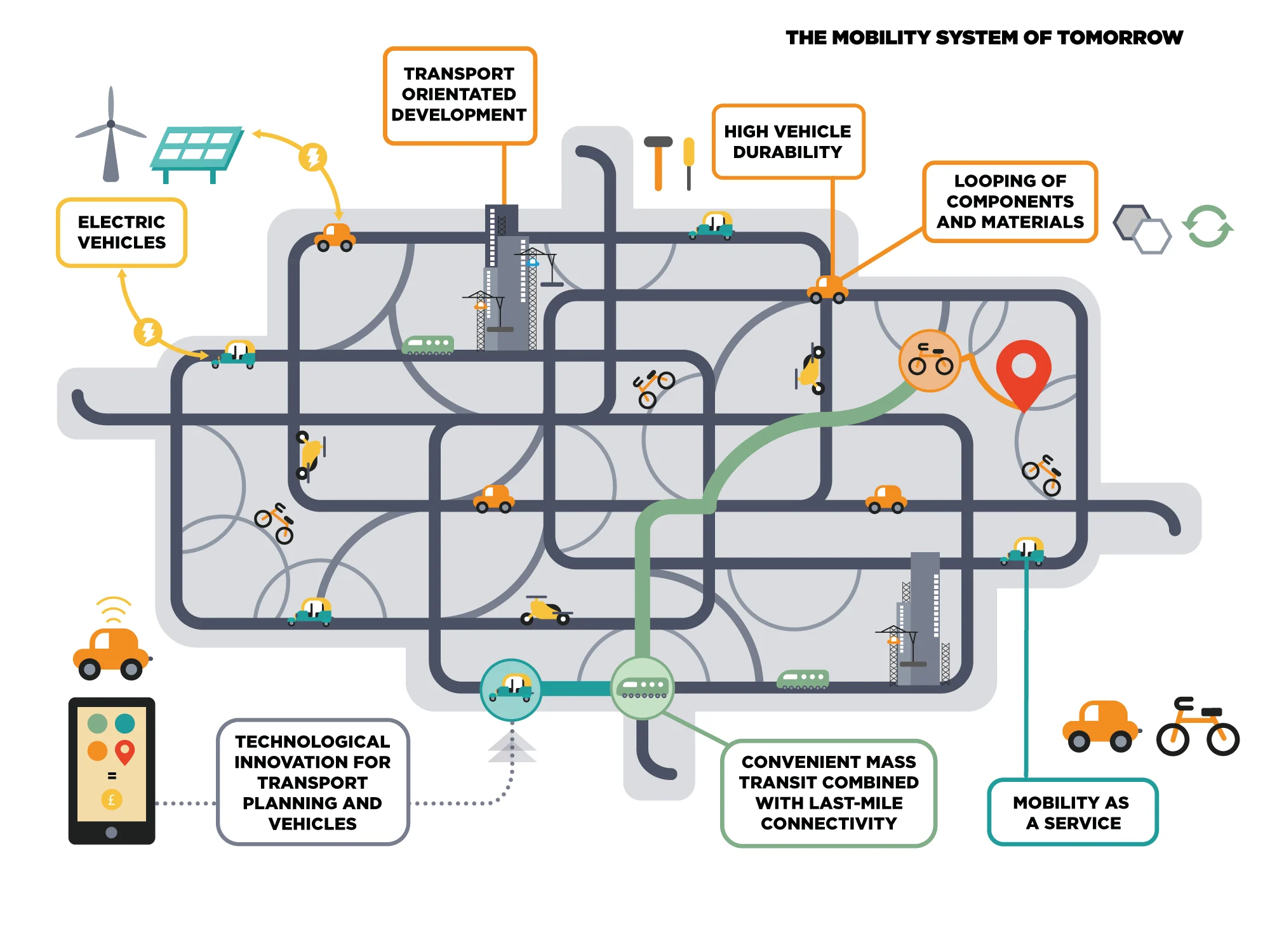

Pause for thought
Imagine you are an urban planner involved in redesigning a city. What are some of the key decisions you would make based on the information in this section?

Food
The current food system is not fit for purpose.
The current food system has supported a fast-growing population and fuelled economic development and urbanisation - but these gains have come at a cost. The system is no longer fit to meet longer term needs.
Case for change
For every dollar spent on food, society pays two dollars in health, environmental, and economic costs
The flow of materials in the food system is overwhelmingly linear - following production it is consumed and the waste is largely discarded. Organic waste in the form of discarded food, by-products, and sewage contains valuable nutrients; however, less than 2% of these biological nutrients are looped back to productive use
One third of food produced globally - worth USD 1 trillion - is wasted each year, yet more than 10% of the world’s population goes hungry
Relying on synthetic fertilisers and pesticides for conventional agriculture pollutes our environment and degrades soils. Agriculture is the world’s second largest emitter of greenhouse gases (after energy production), responsible for roughly 25% of human-caused emissions
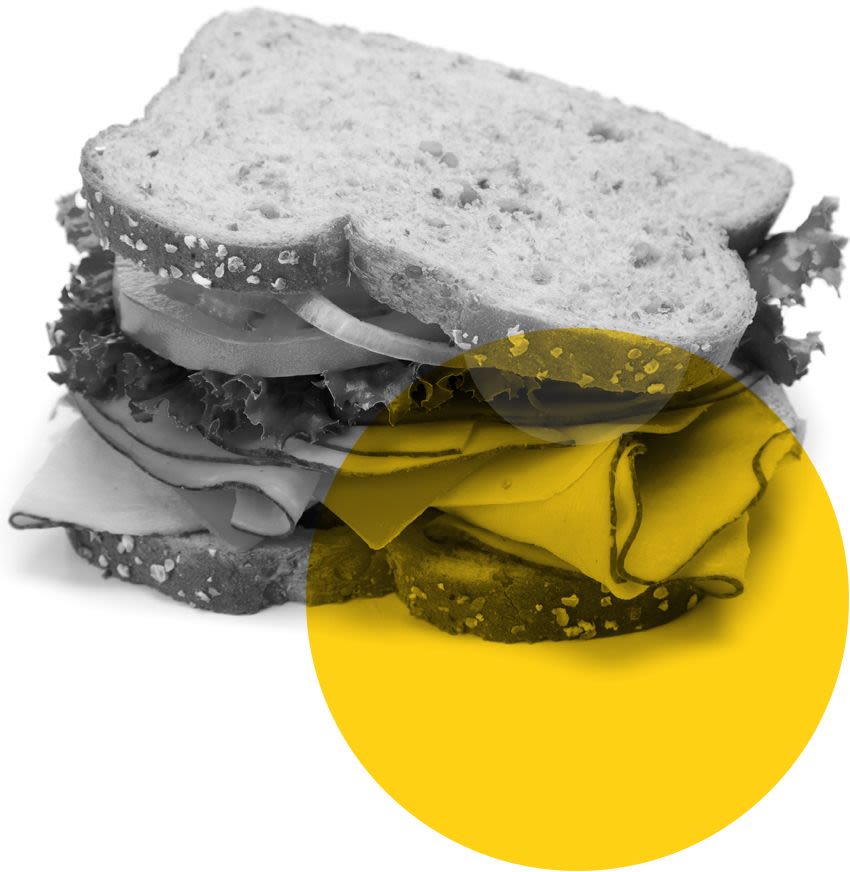
How can cities trigger a shift to a better food system?
Close proximity allows for innovative new business models.
Cities are equipped with technology and have dense networks of highly skilled workers creating ideal conditions for innovation. Their citizens, retailers, and service providers are all in close proximity, making new types of business models possible. This combination of factors means that cities, businesses, and governments, have a unique opportunity to spark a transformation towards a circular economy for food.
From consumer to user.
In our modern economy we depend on a vast array of products. The technologies in these products are advancing so quickly that models soon become obsolete. The mobile phone is a prime example. But while we may revere the functionality of an iPhone, we pay little regard to the many precious materials it contains (an iPhone contains over half of the elements in the periodic table).
Consider the following:
75% of municipal solid waste consists of discarded consumer goods; of which 80% is burned, landfilled or dumped due to poor design and/or lack of end-of-life collection options
80% of household items are used less than once a month
More than 80% of a product’s environmental impact is determined at the design stage
In a thriving city, people would have access to products and services designed using the principles of a circular economy. This would enable them to work, create, communicate, and have a high quality of life without the negative consequences of waste, pollution, ill health, and natural resource depletion. For this model to work, perhaps we need to favour access over ownership, allowing us to use what we need when we need it.

Pause for thought
How do you feel about not owning things? Do you think it is a realistic proposition to make?
Conclusion
Paving the way for a positive future.
The linear economy is ripe for disruption. We have a long way to go, but with interest growing in the circular economy among many different actors - from businesses to policymakers - there is a lot to be excited about. A thriving circular economy in cities will depend on public-private and cross-sector collaboration on an unprecedented scale. Now is the time to take full advantage of the wealth of opportunities in cities to create a system that can work long-term for the economy, society, and environment.
-----------------------
Funded by Eric and Wendy Schmidt Fund for Strategic Innovation


